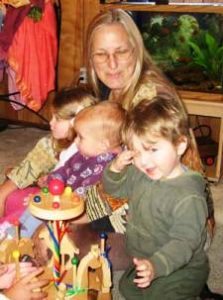 Rahima writes: In 1984 another Waldorf teacher and I dropped out of the school to be home more and opened one of the early home-based Waldorf programs in the country. As lead teacher, I essentially re-created a Waldorf kindergarten for three- and four-year-olds in a dedicated room in her home that opened out into the yard. Since working with 12 children instead of 19 was easy for me, she was free to tend to her new baby and put him down for a morning nap before joining us. This all went on upstairs, away from the children, because who had ever heard of a baby in a Waldorf kindergarten or preschool?
Rahima writes: In 1984 another Waldorf teacher and I dropped out of the school to be home more and opened one of the early home-based Waldorf programs in the country. As lead teacher, I essentially re-created a Waldorf kindergarten for three- and four-year-olds in a dedicated room in her home that opened out into the yard. Since working with 12 children instead of 19 was easy for me, she was free to tend to her new baby and put him down for a morning nap before joining us. This all went on upstairs, away from the children, because who had ever heard of a baby in a Waldorf kindergarten or preschool?
I did hear of other Waldorf teachers using more of their home with the children, or even doing things like brushing the children’s hair and putting lotion on their hands; but I steadfastly offered the same programming I had in the kindergarten at the Waldorf school, just using simpler stories and easier craft projects for the slightly younger group, and everyone was satisfied. We even opened the program to kindergarten children from the school who needed lunch and afternoon care (hard to imagine there were no full-day programs or aftercare in Waldorf schools in those days….).
Fast-forward nearly 25 years, and I was serving on the LifeWays board, because I so supported the LifeWays Principles. My daughter, Faith, had been lead teacher in the toddler program at a local Waldorf free-standing kindergarten, and taking the LifeWays Training had transformed her experience with the toddlers. She jumped at my offer to help set up her own program and teach with her, and Rainbow Bridge LifeWays Program opened in her home in Boulder in August, 2008.
This time we fully embraced two of the principles taught in the Waldorf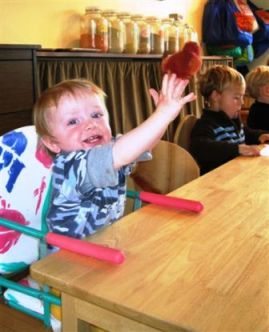 Early Childhood Training, but which are more fully developed by LifeWays: taking home as the model and having mixed-age groups. I had been told that mixed-age kindergartens were much more common in Europe—by which they meant ages 3-1/2 through six years. But LifeWays successfully included very young children in family-like groupings, and we were able to have children from 1-5 years together (the big kids had fall birthdays, so they still went on to kindergarten). We also used all of Faith’s home except for the upstairs, so “home-like” was easy to create with an open living-dining room and kitchen (we even started with a full-sized dining room table with boosters—I liked it a lot, but we soon switched to a child-sized table to make more room for putting on coats and snowsuits).
Early Childhood Training, but which are more fully developed by LifeWays: taking home as the model and having mixed-age groups. I had been told that mixed-age kindergartens were much more common in Europe—by which they meant ages 3-1/2 through six years. But LifeWays successfully included very young children in family-like groupings, and we were able to have children from 1-5 years together (the big kids had fall birthdays, so they still went on to kindergarten). We also used all of Faith’s home except for the upstairs, so “home-like” was easy to create with an open living-dining room and kitchen (we even started with a full-sized dining room table with boosters—I liked it a lot, but we soon switched to a child-sized table to make more room for putting on coats and snowsuits).
We integrated Faith’s brilliance with toddlers (see www.joyfultoddlers.com) with my experience with the older children and developed a rich program that incorporated some of the wonderful Waldorf artistic activities into the LifeWays Living Arts in a more relaxed way than I was used to. For example, we would still tell the same story for two or three weeks—but sometimes it would be at the lunch table, so the little ones would have their food to occupy them. Because I had always loved the puppets, we figured out how to end most stories with a puppet show for our group of twelve. We did a movement circle every day, but it was much shorter and simpler: an opening greeting and “Ring Around the Rosie” every day, and then some fingerplays or a simple game. Beeswax crayons were often available for the children, and occasionally we painted with watercolors; craft projects were rare and more connected with the festivals; the children could help with household tasks and chopping vegetables for the hot lunches, and occasionally we baked bread or cake for a birthday. But mostly we counted on the health-giving power of rhythm and imaginative play, both indoors and outdoors.
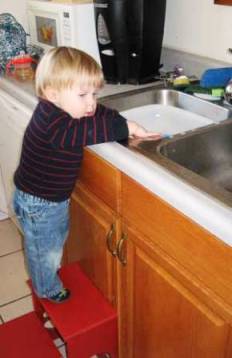 Through the LifeWays principle of valuing time spent in “bodily care” and by having a simpler schedule, we adults were much more relaxed and available for the children. The younger the children, the more they need warmth, love and relationship-based care from their “home-away-from-home” providers. Steiner speaks about the importance of the teacher loving the children, but as a young Waldorf kindergarten teacher I was both too focused on choreographing everything so it would magically appear and too overwhelmed to feel any love in most moments. This time we had a lot more time for sitting and knitting, sipping iced tea or singing a song with the children on our laps.
Through the LifeWays principle of valuing time spent in “bodily care” and by having a simpler schedule, we adults were much more relaxed and available for the children. The younger the children, the more they need warmth, love and relationship-based care from their “home-away-from-home” providers. Steiner speaks about the importance of the teacher loving the children, but as a young Waldorf kindergarten teacher I was both too focused on choreographing everything so it would magically appear and too overwhelmed to feel any love in most moments. This time we had a lot more time for sitting and knitting, sipping iced tea or singing a song with the children on our laps.
We did not try to duplicate or replace the rich Waldorf kindergarten experience. That would not be possible without special times for just the older children. So when children aged out of our program, they went on to kindergarten at the Waldorf school or a public school. However, by providing a rich, home-like childcare/preschool experience that they could be in year after year, we gave the children the advantages of continuity—both of teacher and of peers—that Waldorf so values in the grades and that is even more important for younger children.
My experience was that the children loved being at Rainbow Bridge and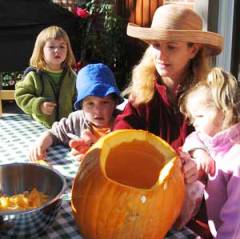 loved being with the other children; I didn’t get the sense that they would be happier or better off at home, one-on-one fulltime with their mothers. I had a similar feeling as the first time I visited a class at a Waldorf school: this must really fit what children need, because there is such a sense of life and joy. Thank you, LifeWays, for letting me be a part of that experience!
loved being with the other children; I didn’t get the sense that they would be happier or better off at home, one-on-one fulltime with their mothers. I had a similar feeling as the first time I visited a class at a Waldorf school: this must really fit what children need, because there is such a sense of life and joy. Thank you, LifeWays, for letting me be a part of that experience!
Rahima Baldwin Dancy is a founding board member of LifeWays North America and has been involved with Waldorf early childhood since 1980. She is internationally known as the author of You Are Your Child’s First Teacher, now available in a third, revised edition.
We thank you for stopping by to enjoy this article. If you would like to share your experiences working with children in a LifeWays home or center, please feel free to contact Mara Spiropoulos at linearmara@gmail.com. She would be thrilled to work with you to share your wisdom and experiences on the LifeWays blog.
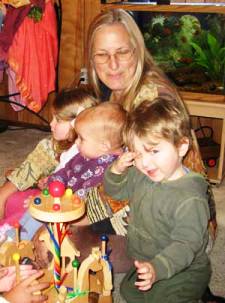
LifeWays In-Home Program
Thank you, Rahima! I love telling our LifeWays students stories about visiting Rainbow Bridge. Observing Faith and you, and later Agaf, was so spirit-lifting. How wonderful to see and feel how your family “lived” so beautifully, and with such open arms, with the little ones in your care. It truly provided them “home away from home”.
I love your reflections
My heart goes out to your clear picture of your journey into this work. This is because I to created a Waldorf kindergarten in my home with young children. There was no model for me to learn from, so I experimented and changed this over the years on my own from my inner world. One day I just realized that these 2 and 3 year olds are not just little 5 and 6 year olds!!! Duuh! Then I found Lifeways and my model was there! I just graduated this Summer and I feel like a completely different teacher. Thanks for all you write!